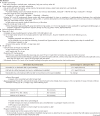High-Intensity Interval Training and Moderate-Intensity Continuous Training in Ambulatory Chronic Stroke: Feasibility Study
- PMID: 27103222
- PMCID: PMC5046191
- DOI: 10.2522/ptj.20150277
High-Intensity Interval Training and Moderate-Intensity Continuous Training in Ambulatory Chronic Stroke: Feasibility Study
Abstract
Background: Poststroke guidelines recommend moderate-intensity, continuous aerobic training (MCT) to improve aerobic capacity and mobility after stroke. High-intensity interval training (HIT) has been shown to be more effective than MCT among healthy adults and people with heart disease. However, HIT and MCT have not been compared previously among people with stroke.
Objective: The purpose of this study was to assess the feasibility and justification for a definitive randomized controlled trial (RCT) comparing HIT and MCT in people with chronic stroke.
Design: A preliminary RCT was conducted.
Setting: The study was conducted in a cardiovascular stress laboratory and a rehabilitation research laboratory.
Patients: Ambulatory people at least 6 months poststroke participated.
Intervention: Both groups trained 25 minutes, 3 times per week, for 4 weeks. The HIT strategy involved 30-second bursts at maximum-tolerated treadmill speed alternated with 30- to 60-second rest periods. The MCT strategy involved continuous treadmill walking at 45% to 50% of heart rate reserve.
Measurements: Measurements included recruitment and attendance statistics, qualitative HIT acceptability, adverse events, and the following blinded outcome variables: peak oxygen uptake, ventilatory threshold, metabolic cost of gait, fractional utilization, fastest treadmill speed, 10-Meter Walk Test, and Six-Minute Walk Test.
Results: During the 8-month recruitment period, 26 participants consented to participate. Eighteen participants were enrolled and randomly assigned to either the HIT group (n=13) or the MCT group (n=5). Eleven out of the 13 HIT group participants attended all sessions. Participants reported that HIT was acceptable and no serious adverse events occurred. Standardized effect size estimates between groups were moderate to very large for most outcome measures. Only 30% of treadmill speed gains in the HIT group translated into overground gait speed improvement.
Limitations: The study was not designed to definitively test safety or efficacy.
Conclusions: Although further protocol optimization is needed to improve overground translation of treadmill gains, a definitive RCT comparing HIT and MCT appears to be feasible and warranted.
© 2016 American Physical Therapy Association.
Figures




References
-
- Billinger SA, Arena R, Bernhardt J, et al. Physical activity and exercise recommendations for stroke survivors: a statement for healthcare professionals from the American Heart Association/American Stroke Association. Stroke. 2014;45:2532–2553. - PubMed
-
- Hornby TG, Straube DS, Kinnaird CR, et al. Importance of specificity, amount, and intensity of locomotor training to improve ambulatory function in patients poststroke. Top Stroke Rehabil. 2011;18:293–307. - PubMed
-
- Boyne P, Dunning K, Carl D, et al. High-intensity interval training in stroke rehabilitation. Top Stroke Rehabil. 2013;20:317–330. - PubMed
-
- Pohl M, Mehrholz J, Ritschel C, Ruckriem S. Speed-dependent treadmill training in ambulatory hemiparetic stroke patients: a randomized controlled trial. Stroke. 2002;33:553–558. - PubMed
Publication types
MeSH terms
Grants and funding
LinkOut - more resources
Full Text Sources
Other Literature Sources
Medical

